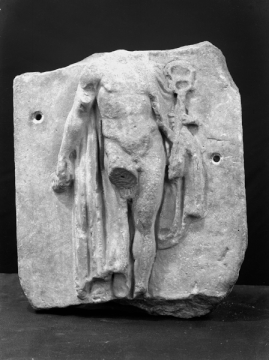Explore Collections


You are here:
CollectionsOnline
/
Fragmentary section of a relief panel(?): facing figure of Hermes
Browse
Fragmentary section of a relief panel(?): facing figure of Hermes
Early 2nd century
Pentelic marble
Height: 34cm
Width: 29cm
Thickness: 7cm
Height (figure): 32cm
Width: 29cm
Thickness: 7cm
Height (figure): 32cm
Museum number: M1132
On display: Colonnade - north wall
All spaces are in No. 13 Lincoln's Inn Fields unless identified as in No. 12, Soane's first house.
For tours https://www.soane.org/your-visit
Curatorial note
Hermes, carved almost full face in high relief, with herald's staff in the crook of his left arm, purse in his lowered right hand, stands with left hip thrust out, throwing his weight decidedly onto his left leg. A long chlamys covers the back of his shoulders, is draped over his left arm below the staff, and falls down in long vertical folds behind his right arm.
The setting of the relief cannot be immediately determined from the fragment in its present condition. From the thin, flat panel on which it is mounted, the figure perhaps formed part of a secondary architectural panel or even, from the isolation of the figure itself, an inset in an altar or sculptured base, though the first suggestion seems more likely. The Hermes type in relief, standing with weight on the left leg, the torso somewhat contorted, the chlamys about the neck (?) and down the back off the shoulders and over the left arm, all forming a setting for the nude torso, is found in several now well known Imperial reliefs and has been conjectured by G. Guidi1, in discussing a relief from the late Antonine Theatre at Sabratha (or Sabrata) in Libya, as a Roman reflection of the Greek Hermes of Myron. The best example of this Hermes in monumental, triumphal relief, a larger scale, later version of this Soane figure, appears on the Arch of the Severi at Leptis Magna2, also in Libya, and is also identified by Bartoccini with the Myronic type. This Soane relief appears to be earlier second century work of considerable life and quality and has its decorative counterpart in a terracotta statuette let into a wall in the Villa Medici, in Rome3.
1 G. Guidi, Africa Italiana, III, 1930, p. 26, n.1
2 Renato Bartoccini, Africa Italiana, IV, 1931, p. 88, fig. 55.
3 A. Andrén, Opuscula Archaeologica III, 1944, pp. 37ff.
The setting of the relief cannot be immediately determined from the fragment in its present condition. From the thin, flat panel on which it is mounted, the figure perhaps formed part of a secondary architectural panel or even, from the isolation of the figure itself, an inset in an altar or sculptured base, though the first suggestion seems more likely. The Hermes type in relief, standing with weight on the left leg, the torso somewhat contorted, the chlamys about the neck (?) and down the back off the shoulders and over the left arm, all forming a setting for the nude torso, is found in several now well known Imperial reliefs and has been conjectured by G. Guidi1, in discussing a relief from the late Antonine Theatre at Sabratha (or Sabrata) in Libya, as a Roman reflection of the Greek Hermes of Myron. The best example of this Hermes in monumental, triumphal relief, a larger scale, later version of this Soane figure, appears on the Arch of the Severi at Leptis Magna2, also in Libya, and is also identified by Bartoccini with the Myronic type. This Soane relief appears to be earlier second century work of considerable life and quality and has its decorative counterpart in a terracotta statuette let into a wall in the Villa Medici, in Rome3.
1 G. Guidi, Africa Italiana, III, 1930, p. 26, n.1
2 Renato Bartoccini, Africa Italiana, IV, 1931, p. 88, fig. 55.
3 A. Andrén, Opuscula Archaeologica III, 1944, pp. 37ff.
Unrecorded
Literature
A. Michaelis, Ancient Marbles in Great Britain, trans. C.A.M. Fennell, Cambridge, 1882, p. 480, no. 34.
Soane collections online is being continually updated. If you wish to find out more or if you have any further information about this object please contact us: worksofart@soane.org.uk


